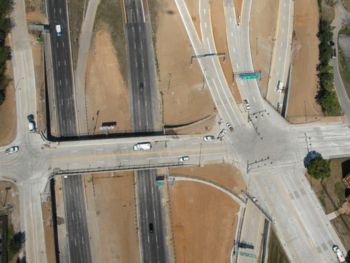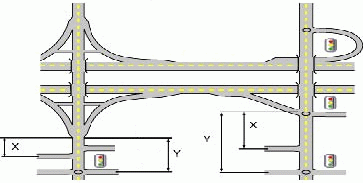Difference between revisions of "940.3 Clearance of Functional Areas of Interchanges"
m (Per Traffic, Fig 940.3 was revised to remove "z", the distance from last right-in, right-out opportunity to baseline on-ramp) |
m (article construction) |
||
| Line 1: | Line 1: | ||
| − | [[image:940.3 clearance of functional.jpg| | + | [[image:940.3 clearance of functional.jpg|left|350px]] |
Adequate space is needed for traffic to make the transition from a road with interchanges to a road with at grade access points. The functional area of the interchange is where merging and diverging of traffic takes place. Drivers must travel along an exit ramp, find acceptable gaps, change lanes (weave) and merge within this distance. | Adequate space is needed for traffic to make the transition from a road with interchanges to a road with at grade access points. The functional area of the interchange is where merging and diverging of traffic takes place. Drivers must travel along an exit ramp, find acceptable gaps, change lanes (weave) and merge within this distance. | ||
| − | + | {|style="padding: 0.3em; margin-right:20px; border:1px solid #a9a9a9; text-align:center; font-size: 95%; background:#f5f5f5" width="180px" align="right" | |
| + | |- | ||
| + | |'''Additional Information''' | ||
| + | |- | ||
| + | |[[Functional Intersection Area|Functional intersection area]] | ||
| + | |} | ||
A safe distance for this activity is to be provided from the end of the off ramp to the first driveway, median opening or intersection with a public road. This is measured from the point of intersection of the ramp baseline and roadway centerline. When only right turns into or out of driveways or public roads are involved, a shorter clearance area may be used. These guidelines also apply to on-ramps and off ramps not associated with an interchange. | A safe distance for this activity is to be provided from the end of the off ramp to the first driveway, median opening or intersection with a public road. This is measured from the point of intersection of the ramp baseline and roadway centerline. When only right turns into or out of driveways or public roads are involved, a shorter clearance area may be used. These guidelines also apply to on-ramps and off ramps not associated with an interchange. | ||
Revision as of 07:45, 12 June 2009
Adequate space is needed for traffic to make the transition from a road with interchanges to a road with at grade access points. The functional area of the interchange is where merging and diverging of traffic takes place. Drivers must travel along an exit ramp, find acceptable gaps, change lanes (weave) and merge within this distance.
| Additional Information |
| Functional intersection area |
A safe distance for this activity is to be provided from the end of the off ramp to the first driveway, median opening or intersection with a public road. This is measured from the point of intersection of the ramp baseline and roadway centerline. When only right turns into or out of driveways or public roads are involved, a shorter clearance area may be used. These guidelines also apply to on-ramps and off ramps not associated with an interchange.
- X = Distance from baseline off-ramp to first right-in, right-out driveway/public road intersection.
- Y = Distance from baseline off-ramp to first major public road intersection, full median opening, or left-turn opportunity.
Spacing greater than the distances shown is advantageous for safety and operations.
| Type of Area | Distance from Ramp to RightIn, Right-Out Driveway (X), ft. | Distance to First Major Public Road Intersection, Full Median Opening, Or Left-Turn Opportunity (Y)*, ft. |
|---|---|---|
| Major | 750 – 1,320 | 1,320 – 2,640 |
| Minor | Generally Not Applicable | Generally Not Applicable |
| *Left turns are not to be allowed in this section of roadway. The public road intersection is likely to become a signalized intersection as the interchange area develops. Right –in, right –out driveway configuration is to include a non-traversable median. | ||
Note: All ramp measurements are taken to or from baseline ramp.
Clearance less than the range in the above table is to be supported by a study of alternatives to ensure safety and traffic flow. All reasonable alternatives, including relocating the interchange to a different location, are to be considered. Other alternatives to be examined may include installation of raised medians, construction of a single point urban interchange, the use of roundabouts at the ramp and or outer road intersections or alternative access ways such as frontage and backage roads.

